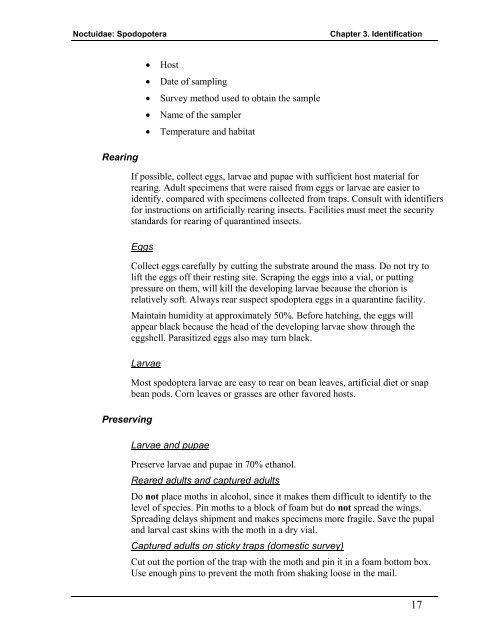New Pest Response Guidelines - Phytosanitary Resources
New Pest Response Guidelines - Phytosanitary Resources
New Pest Response Guidelines - Phytosanitary Resources
Create successful ePaper yourself
Turn your PDF publications into a flip-book with our unique Google optimized e-Paper software.
Noctuidae: Spodopotera<br />
Chapter 3. Identification<br />
• Host<br />
• Date of sampling<br />
• Survey method used to obtain the sample<br />
• Name of the sampler<br />
• Temperature and habitat<br />
Rearing<br />
If possible, collect eggs, larvae and pupae with sufficient host material for<br />
rearing. Adult specimens that were raised from eggs or larvae are easier to<br />
identify, compared with specimens collected from traps. Consult with identifiers<br />
for instructions on artificially rearing insects. Facilities must meet the security<br />
standards for rearing of quarantined insects.<br />
Eggs<br />
Collect eggs carefully by cutting the substrate around the mass. Do not try to<br />
lift the eggs off their resting site. Scraping the eggs into a vial, or putting<br />
pressure on them, will kill the developing larvae because the chorion is<br />
relatively soft. Always rear suspect spodoptera eggs in a quarantine facility.<br />
Maintain humidity at approximately 50%. Before hatching, the eggs will<br />
appear black because the head of the developing larvae show through the<br />
eggshell. Parasitized eggs also may turn black.<br />
Larvae<br />
Preserving<br />
Most spodoptera larvae are easy to rear on bean leaves, artificial diet or snap<br />
bean pods. Corn leaves or grasses are other favored hosts.<br />
Larvae and pupae<br />
Preserve larvae and pupae in 70% ethanol.<br />
Reared adults and captured adults<br />
Do not place moths in alcohol, since it makes them difficult to identify to the<br />
level of species. Pin moths to a block of foam but do not spread the wings.<br />
Spreading delays shipment and makes specimens more fragile. Save the pupal<br />
and larval cast skins with the moth in a dry vial.<br />
Captured adults on sticky traps (domestic survey)<br />
Cut out the portion of the trap with the moth and pin it in a foam bottom box.<br />
Use enough pins to prevent the moth from shaking loose in the mail.<br />
17













